After more than a year of Covid cabin fever, the landscapes of the west called out to cooped up Americans, who arrived in greater numbers than ever before. As a result, 2021 saw bucket-list parks – including Yellowstone, Grand Teton, Zion, Arches, Canyonlands and Glacier – smash their previous visitation records.
But the mass exodus into the outdoors has come at a cost. The 1960s-era wastewater system in Yellowstone was pushed to the brink. Arches temporarily closed 120 times because all the parking lots were full. The Grand Canyon struggled to cope with a record number of rescues, and an influx of remote workers have driven rents sky high in gateway towns such as Jackson Hole, Wyoming.
Interviews with park supervisors, staff and guests paint a picture of a system under increasing strain and struggling to adapt to this new reality. National parks have become the go-to destination for vacationers craving dazzling sights at a social distance, but the surge has collided with a host of existing problems on public lands, including years of underinvestment.
That has left staff overwhelmed and guests frustrated.


“The whole country had been pent up and everybody decided to come to the American west at the same time,” says Jason Williams, chair of the Jackson Hole chamber of commerce and owner of a wildlife tour company. “Last summer people were rolling into town without reservations or a plan but they had very high expectations.”
Now that the chaotic tourism season is over, park superintendents are taking a deep breath and examining how Covid has changed America’s relationship to the outdoors.
The record turnout has been a phenomenon largely affecting parks in the western US, and marks a shift from 2020, where people were more likely to visit parks closer to home. That changed when the relaxing of Covid restrictions made wild, celebrated landscapes more accessible, and park authorities say that will continue.
For Chip Jenkins, the superintendent of Grand Teton, which saw a record 3.8 million visitors in 2021, that means balancing the benefits of more people heading outdoors with the logistical challenges of accommodating them.
“I am thinking about what this means for 2022 but also for 2042,” says Jenkins. “How are we going to preserve a high-quality visitor experience?”
It’s not Disneyland: park staff strained by larger crowds
Inspired by well-funded state tourism campaigns and an endless feed of beautiful photos on Instagram, Americans headed to crown jewel parks expecting a picture-postcard experience. But the upbeat marketing pitches glossed over the fact that Covid coincided with a period of chronic underfunding.
According to the not-for-profit National Parks Conservation Association, National Park Service staff has shrunk by 14% over the last decade, primarily due to federal funding cuts. Total visitation to all national park properties has increased by 20% during the same period. Making the situation even more difficult were staff housing restrictions and supply chain problems created by Covid.
While visitors would find the Tetons or Delicate Arch as spectacular as ever, they would also discover there were not enough park employees to shoulder the increased demand for basic services like cleaning bathrooms or answering questions at visitor centers. Tourists in gateway towns also encountered closed restaurants due to lack of staffing, empty store shelves caused by supply chain problems, hotels that were booked out for months, traffic jams and frazzled local residents.
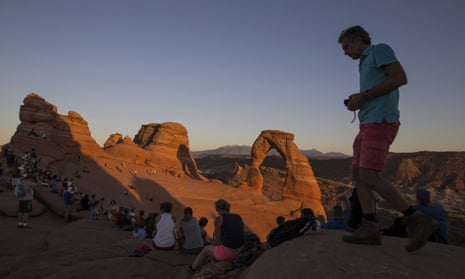
In Yellowstone – where visitation hit 4.4 million in 2021, a million more than in 2020 – the sudden influx created a kind of operational whiplash. “Historically, we had 20 years between each additional million visitors and there was plenty of time to adjust,” says Cam Sholly, Yellowstone’s superintendent. “But getting that increase in just a 12-month period made it hard to react fast enough.”
Sholly says the primary impact of last year’s visitor increase was the extra stress placed on park infrastructure and staff rather than on the wild landscape. “All of a sudden we are having to clean the bathrooms five times a day instead of three,” he says. “And we are needing to empty 2,000 trash cans more often.”
Supply chain problems caused food to run low at even the most highbrow Yellowstone restaurants and hotels. And staffing shortages often left dining rooms without enough servers. Chris Schultz and his wife visited the park’s Old Faithful Inn in late September. Given the hotel’s historic reputation and $500-a-night price tag, they had high expectations but came away disappointed. “The only thing you could get for breakfast was a cold bagel that was being served out of a cooler,” says Schultz, who lives in Tennessee.
Yellowstone visitor activity traditionally tapers off in the fall when snow arrives, but last year the park set a September visitation record of more than 9,000 people. Park managers say attractions like Old Faithful and Mammoth Hot Springs are now just as packed in the fall as they are during summer.
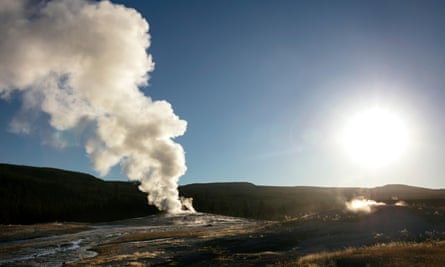

“Yellowstone reached the point several years ago where there are more visitors inside the park than there are services to accommodate them,” says Mike Keller, general manager for Yellowstone National Park Lodges. But Keller, who has worked at Yellowstone for 30 years, does not think adding more hotel rooms or camp grounds is going to solve the problem. He is more interested in educating new park visitors about how Yellowstone’s rustic atmosphere is very different from places like Disneyland – and he wants it to stay that way.
“I saw more visitors come to Yellowstone who were unprepared for what the park experience is like,” he says. “We have never had TVs or swimming pools in our hotels. But there were so many times when guests would complain about it to our employees, saying they didn’t know what to do with their family at night. There was a real fatigue for staff caused by visitors wanting services that we don’t offer.”
Danger for visitors who are ‘underestimating the challenges’
Park staff say a lack of preparedness, particularly among newcomers who may underestimate the extremes of these wild places, has driven up search and rescue costs and monopolized ranger time.
In Grand Canyon national park, the strain of backcountry rescues has become especially acute. Though visitation decreased in 2021 due to a drop in international tourism, park rescues increased by 30% compared with the annual average. The park carried out at least 400 backcountry evacuations in 2021, the most in 20 years.
The park informs people about the challenges of hiking in the canyon, where temperatures routinely climb into the triple digits and trails are relentlessly steep, but Grand Canyon superintendent Ed Keable says many of last year’s first-time visitors to the park did not heed those warnings.
“They were underestimating the challenge and overestimating their physical abilities,” says Keable. “They were just so eager to get out and hike but they were not as fit as they had been before the pandemic.”
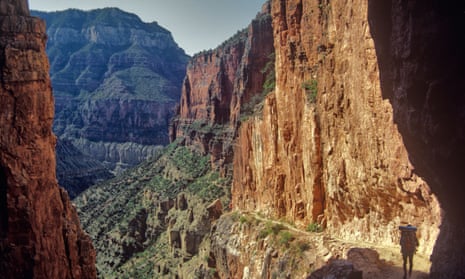
While the rescue data from Grand Canyon and other parks show that the new visitors are often lacking in preparation or a sense of caution, they also share other characteristics, according to a recent study conducted by social scientists at the University of Montana, Penn State and the Leave No Trace Center for Outdoor Ethics. The study surveyed nearly 5,000 adults across the United States during May and June 2021 to find out who was recreating outdoors during Covid. The results revealed a fairly homogeneous group: people who are predominantly white, middle aged and have slightly higher than average disposable incomes.
“It turns out the new outdoor recreationists are not very different demographically from the existing recreationists,” says Peter Newman, a co-author of the study and a professor with Penn State’s department of recreation, park and tourism management. The survey found that 76% of the outdoor recreation newcomers were white; 73% of people who had been going outdoors before Covid were white. Meanwhile, people who had been recreating outdoors but dropped that activity during Covid were predominantly people of color and lower income.
These demographics mirror a longstanding lack of diversity among national park visitors. According to a 2015 National Park Service report, only 20% of domestic national park visitors were people of color despite the fact they make up 40% of the US population.
“The new visitors going to parks during the pandemic were people who had fewer constraints economically and more flexibility related to work,” adds Rice.
Squeezing out locals
Remote working has played a large role in bringing more people into gateway communities that surround national parks. Outdoor recreationists and wealthy families fleeing cities during the pandemic for scenic rural communities have sent rents spiking in destinations such as Jackson Hole, Wyoming, which is just outside Grand Teton and is near Yellowstone.
Residents in Jackson Hole say that many of the houses in the 10,000 population town that had been rentals for service industry workers and ski bums have been bought to be torn down for new construction. The average price of a house in Jackson Hole is $2.5m, more than double what it was a decade ago, and rent for housing set aside for service industry workers over the summer started at $3,000 a month for a 400 sq ft apartment.
The result is an inflated housing market that’s priced out longtime residents. “Tourism drives interest in Jackson Hole, and that interest drives real estate investment, which then raises the cost of living and changes the labor market entirely,” says Chris Dickey, who has lived in Jackson Hole for 17 years and owns a digital marketing agency. “People visit the area a few times and then decide they want to move here. There are plenty of people out there willing to pay $3m to $5m for a home in Jackson Hole, but the problem is that’s not a price locals can afford.”

Dickey has observed that many new residents in Jackson Hole come from urban centers like San Francisco and New York City. They are tech executives, finance industry professionals and successful entrepreneurs.
Dickey acknowledges that park visitors are an essential part of the thriving Jackson Hole economy but all the attention can also pose an existential threat. “The real problem is not the crowds or traffic but the loss of our community because no one can afford to live here any more,” he says. “That is the true cost of tourism.”
Park leaders are hopeful that a watershed of new federal funding set aside for parks will at least begin to tackle some of these challenges. Joe Biden’s infrastructure bill includes $1.7bn for roads, bridges and other improvements inside national parks, while a bill currently under consideration in Congress contains a proposed $2.93m for National Park Service operations that would facilitate hiring more than 1,000 additional Park Service rangers and other employees, as well as funding for diversity and inclusion programs.
“The politicians in DC now know the public really loves these places and wants more investment in them,” says Kristen Brengel, senior vice-president of government affairs for the National Parks Conservation Association.
As for managing crowding, parks that experienced the most congestion during Covid are looking at ways to require online reservations before arriving. Arches national park is implementing a timed entry system, while Zion will soon require permits for its popular day hike to Angels Landing. Online entry reservations that were implemented during 2020 at Rocky Mountain and Yosemite national parks as Covid precautions will probably stay in place.

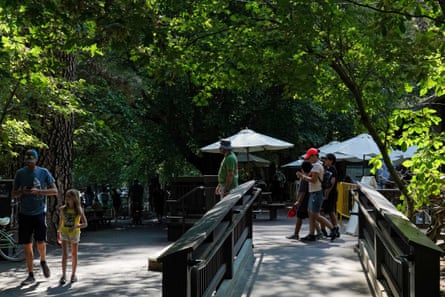
But national park advocates and managers worry that these systems could further alienate the people who are not visiting America’s crown jewels.
“What park managers are doing to control impacts from increased visitation could make the parks less accessible to people of color or lower income,” says William Rice, a professor of outdoor recreation and wildland management at the University of Montana and a co-author of the study on Covid-era park visitation. Rice points out that problems with internet speeds, digital literacy and knowledge about new requirements can pose additional barriers for certain groups. For example, the primary National Park Service reservation site, Recreation.gov, is only in English.
“Our research serves as a note of caution to land managers and the tourism community at large,” he says. “Covid had negative impacts on efforts to create a more inclusive outdoors. We need to figure out how to distribute our nation’s recreation resources more equitably.”
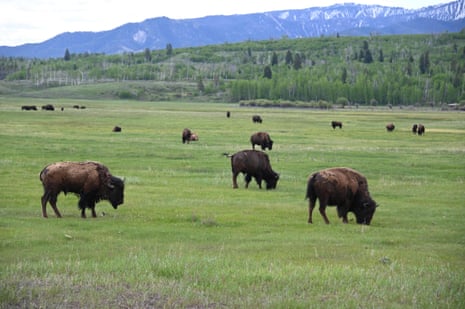
This article was amended on 4 January 2022 to correct that the number of backcountry evacuations conducted in the Grand Canyon in 2021 was the most in 20 years, not in the park’s history.
